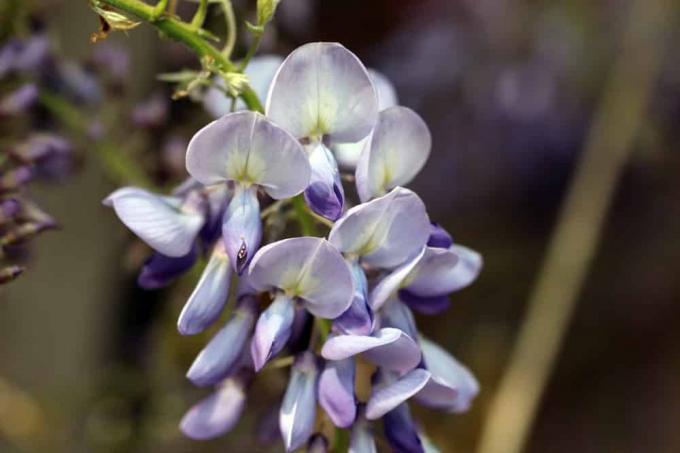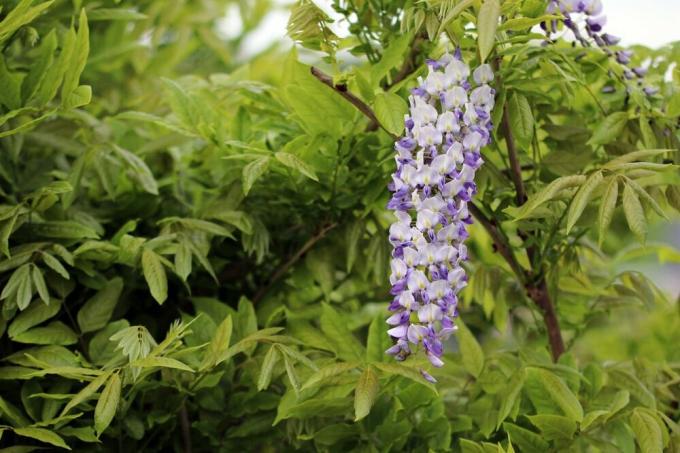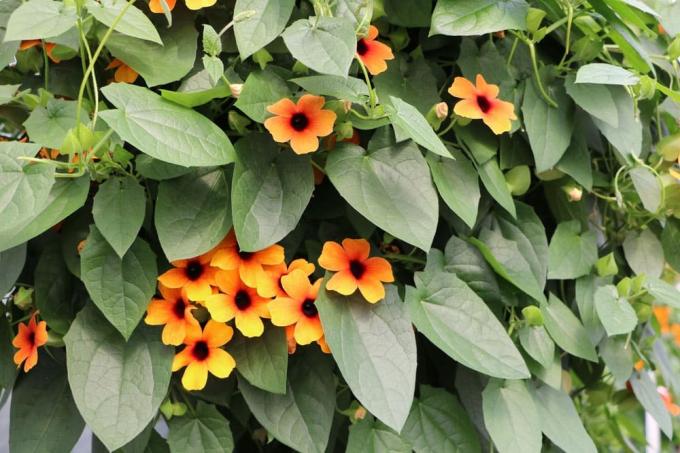

Table of contents
- Note location
- Choose the best substrate
- Plenty of water promotes flowering
- Well-dosed fertilization
- Repot with care
- Cut back in a targeted manner
- Be patient and choose the best variety
Decorative, imposing and easy to care for - the wisteria inspires more and more hobby gardeners. The plant with the lush blue flowers is a visual highlight, especially in ornamental gardens. The disappointment for every garden owner is all the greater when the wisteria does not bloom or only blooms poorly; then it is important to find the cause of the flowering laziness so that the plant quickly becomes the usual eye-catcher again.
Note location
Mistakes in cultivation are often responsible for the sluggishness of wisteria; The location in particular plays an important role here. Wisteria thrives best in full sun; here the flowers can develop optimally. A warm and sunny south face is best.
Even if the plant is cultivated in partial shade, significantly fewer flowers form, while a completely shady place can sometimes lead to complete failure.
It is important to choose a spacious location and to attach a climbing aid so that all the flowers created can develop optimally. The following variants have proven themselves:
- plastic rods
- metal grid
- wire ropes
A notice:
Wisteria should never be placed too close to a gutter where it could climb up and cause damage.
Choose the best substrate

If the wisteria does not bloom or only blooms insufficiently, the use of an unfavorable substrate can also be the cause, because the plant makes special demands on the soil. The soil used should be rich in nutrients and low in lime at the same time. If the substrate contains too much lime, not only will the leaves turn yellow, but the general willingness to flower will also decrease. A high proportion of humus, on the other hand, has a fundamentally positive effect on the formation of the flowers; in addition, it is important to adjust the correct pH in the soil. The flowers develop best when the substrate has acidic to neutral properties. The soil should also be moist but permeable to water.
Plenty of water promotes flowering
The wisteria impresses above all with its lush flowers; In order for them to develop optimally, the plant needs a lot of water, especially during the summer months. So that the flow of liquid does not dry up even on hot and dry days, it has proven useful to place the lower part of the plant bowl in water.
Tip:
The wisteria is one of the few plants that do not react with the dreaded root rot if they are too wet. That's why watering should be done with courage!
Well-dosed fertilization
One of the most common reasons for the flowering laziness of the wisteria is insufficient or incorrect fertilization; here, even the smallest mistake can have a maximum effect on the plant's willingness to flower or completely inhibit flower growth. The following aspects should be considered when fertilizing:
- Heavy fertilization occurs after flowering
- This nutrient supply should be done by July
- Then the fertilizer is reduced
- Any high-quality bloom fertilizer is suitable
By varying the amounts of fertilizer, the hobby gardener ensures that the wisteria will nourish the flower buds for throughout the next year while at the same time limiting the growth of foliage during the summer holds.
Repot with care
Many hobby gardeners tend to repot the plant too often due to the strong growth of wisteria. However, the frequent change of pots considerably reduces the willingness to bloom, so that a time interval of at least five years should be observed between repotting.
A notice:
Anyone who rarely repots promotes a gradual compaction of the root ball, which also promotes the formation of flower buds. In return, however, this compaction makes watering from above more difficult, which is why it is doubly important to water the wisteria from below, especially during the hot season.
Cut back in a targeted manner

A targeted pruning is important for optimal flowering. From the third year, this must be done according to the following guidelines:
- New shoots are cut back by half
- The pruning takes place in late summer
- New outgrowths grow again on the cut shoots
- These must be shortened to three to five eyes at the end of February
- Shoots without green are to be removed completely
A notice:
Incorrect pruning can also accidentally remove shoots that form flowers. Therefore, cutting young or one-year-old shoots should be avoided; if necessary, leading shoots can be thinned out into perennial wood.
Older specimens of the Wisteria often suffer from flowering laziness. Here, too, a pruning can help, which in this case can be radical. If you shorten the plant by 40 to 50 cm, you will be able to look forward to numerous new flowers in the following year.
Be patient and choose the best variety
Anyone who has observed all of the above aspects and still notices a certain laziness in flowering in their wisteria should consider that the plant will not flower for three years at the earliest. If the plant is not pruned, the flowering can be even further delayed. In addition, the right variety of wisteria is crucial for flowering speed; some varieties only develop their first flowers after 10 years. The following information on the varieties and species should be observed:
- Japanese wisteria grows weaker and blooms only after 10 years
- Issai Perfect flowers after just three years
- Grafted plants flower much better
A notice:
Plants propagated from seed rarely flower overall.
There are many causes of wisteria sluggishness. But if the hobby gardener first pays attention to a suitable and fast-flowering variety, then the plant in a suitable location cultivated, cared for and pruned in a targeted manner, he can see the luxuriant blooms in his home garden every year be happy.
 garden editorial
garden editorial I write about everything that interests me in my garden.
Learn more about climbing plants

Is black-eyed Susan poisonous?
Black-eyed Susanne can delight all of our eyes with colorful flowers. But if small children or pets are around it, it is important that we also clarify whether it is possibly poisonous. The answer to that is clear and a little surprising!

Black-eyed Susanne, Thunbergia alata: Care from A – Z
Black-eyed Susanne is one of the most popular climbing plants. It is ideal for greening house walls, balconies, fences and pavilions. If you follow our care tips, you will enjoy the splendor of their flowers.

How fast does wisteria grow? | Information about growth
As its name suggests, the wisteria, as an intensive climber, enriches walls, trellis structures and other possibilities for spreading a magnificent, glowing blue sea of flowers. You can find out what you should consider when growing with us in a simple and understandable way.

How fast does Virginia creeper grow? | Information about growth
If you want a trellis or a house wall to be lushly greened, you will find a grateful partner in Virginia creeper. Over time, it can grow into large areas and, especially in autumn, enrich it with colorful foliage. Contact us for helpful information on growth.

Evergreen honeysuckle: care from A to Z
The evergreen honeysuckle is popular for greening walls or fences, because the creeper is green all year round and has beautiful delicate flowers. Although the honeysuckle is not very sensitive, it needs a minimum of care for it to develop well.

How fast does ivy grow? | Accelerate growth effectively
Ivy (Hedera helix) is a true climber that climbs up walls and house walls without any problems and can have a very decorative effect. Once it has taken root, it can literally overgrow large areas in a very short time. You can literally watch him grow.



